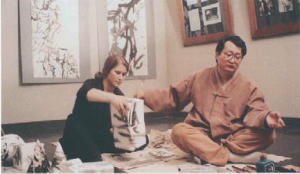Many congratulations to the two WSA PGR Alumni who have published articles in the latest issue of Journal of Contemporary Painting (vol. 6 issue 1-2). It is wonderful to see alumni making such a contribution to art criticism. Some details below of both these contributions to scholarship
Feng Jie (2021) ‘Writing from the other side: Critical reflections on the calligraphy of Zhang Qiang’ Journal of Contemporary Painting, Vol. 6, Issue 1-2, pp. 131-148 [available here].
This article presents the specific case of a contemporary practitioner of Chinese calligraphy, Zhang Qiang, a notable figure within the current Avant-garde movement. After outlining aspects of his practice, which has been controversial along gender grounds, the article turns to his specific project of ‘bi-directional’ calligraphy. It is argued this work opens up a more rewarding way into his work as an enquiry into writing, which bears connections with Derrida’s deconstructionist account of writing and trace. However, in a brief exchange at Tate Modern, Zhang offers a form of ‘writing lesson’, which both helps takes us towards the decontructionist account of general writing, yet equally reveals a reliance upon the cultural category of ‘Chinese calligraphy’, which takes us away again—arguably symptomatic of a wider struggle for Chinese contemporary art to gain recognition in the West.

Cheng-Chu Weng (2021) ‘Making minimalism disappear…’ Journal of Contemporary Painting, Vol. 6, Issue 1-2, pp. 149-164 [available here].
‘Making minimalism disappear…’ presents an essay regarding my approach to ‘expansion painting’, and specifically provides a study of another kind of minimalist aesthetic. The account begins with a signature work, Shoji (2015), which is proposed as a way to unfold what expansion painting is. I describe my approach as drawing upon painterly compositional methods but developed through site-specific considerations of architectural spaces, bodies and differing levels of consciousness. The works ‘take place’ when interacting in these layered spaces, or what I refer to as a ‘sense’ of painting space. The article goes on to articulate how—in terms of a western discourse – my works might ‘look’ minimalist but, in fact, are not minimalist art. This article—in representing my practice and providing broader critical analysis—leads us to question an ideology of art history around the enigma of minimalist art, and gives rise instead to another shadowy form of minimalist art. Hence, this article can be said to make minimalism disappear in being haunted by it.
You can also see Cheng-Chu’s PhD practice and contributions to WSA’s PhD researcher community featured on this blog here.